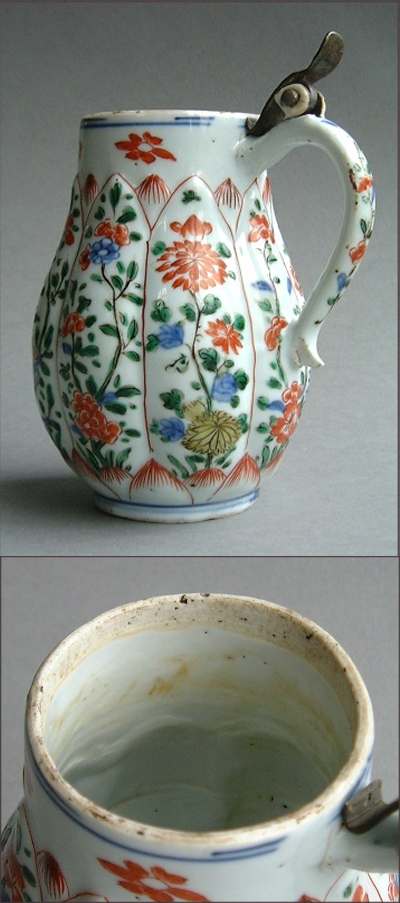
This page is only one of many thousands of Gotheborg.com Help and Information Pages, offering specialized knowledge on Chinese and Japanese Porcelain, including a Glossary, Q&A, Chinese and Japanese Porcelain Marks, Chinese Porcelain Exhibition and Excavation reports etc. For personal help and far more information, join our Discussion Board or use 'Ask a Question' for quick email consultations. For full text and better navigation, use a full-screen device rather than a mobile phone, that offers only limited content.
 ---------
---------
Dear All,
I'd be interested in your views on the desirability or otherwise of cleaning a piece of antique Chinese porcelain.
As an example, I have recently bought a famille verte tankard. The inside is quite stained, and the footrim is dirty. Do you think that the dirt is like the patina on antique furniture, and needs to be preserved (and indeed adds value to the item) or would the item be improved by giving it a good wash?
I look forward to hearing your opinions!
Ian Rodgers
Dear Ian,
I can only tell for myself - but I feel that porcelain should be as clean as possibly. If it is an enameled piece it pays to be careful with the enamels, though, especially with any old gilt, which is easily damaged.
Jan-Erik Nilsson
Dear Ian,
Any chance you can post photos of the piece and the stains? I'd be cautious about the denture cleaner. I don't know what's in it.
Thanks, Scott.
Dear Ian,
I'm not sure why the inside of your famille vert tankard should be stained. Chinese export porcelain usually has a very hard glaze that fuses well with the body and therefore resists staining. The Chinese did produce a porcelain that we call "soft paste" or Steatitic porcelain that is very porous with a glaze that is very prone to crazing that stains easily. It usually is decorated in blue and white. I have seen pieces of porcelain that were buried that have become stained but I assume that your tankard is 300 years old or newer and is not the kind of thing that was regularly buried. Pottery stains easily. Staffordshire transferware is often stained. Your piece might just be dirty and not stained. I have however seen alot of new pieces that have a stain that was applied to make them look old. I always give my new porcelain purchases a careful bath. These things were intended to be used and washed. Clean they are as bright and glorious as the day they came out of the kiln. If your piece is porcelain and Chinese export and does not come clean then I would begin to worry. The new "patina" does not wash off easily. If your piece is really stained it can be cleaned. Hydrogen Peroxide is used to gently lift out stains in a slow process that involves soaking and then baking in a warm oven. NEVER use chlorine bleach! It may clean the stain but it gets under the glaze and eats the body of the piece so that the glaze will pop off. I hope this a help.
Scott Gladden.
Dear Scott,
Thank you for your useful comments. Well that's 2 votes out of 2 so far for a thorough cleaning!
That's a timely warning for me - I was considering the use of dilute bleach! As the inside of my tankard has pale brownish stains only in the hard-to-reach areas - the tankard has a broad body but a relatively narrow neck - I am going to assume that this is a 'genuine' rather than fake stain.
Any views on whether those tablets designed for cleaning dentures might be safe and do the trick?
Regards,
Ian
Wiltshire U.K.
Incidentally, being of an experimental frame of mind I tried using a denture tablet in hand-hot water in the lower half of the tankard. The stain was almost completely removed (but not, I'd delighted to say, the glaze!). For the record, the active ingredients in the tablet are Sodium bicarbonate, Sodium sulphate, Potassium monopersulphate, Sodium carbonate, PEG-150, PEG-75 and malic, citric and sulphamic acids. Does that mean anything to anyone?
Regards,
Ian (owner of a unique half-stained, half-cleaned tankard!)
RE: Cleaning tablets
It makes sense that this preparation was effective for removing a certain type of stain. The components are common reagents useful for the solubilization of organic matter. Salts & some weak organic acids help solubilize the stain. A buffer keeps the solution within a certain pH range. Soluble polymers (listed as as PEG) can help make the suspension homogeneous, and depending on concentration, may be used to increase the effective concentration of mixture components.
A "carbonate buffer" is apparently used in this preparation. If correctly formulated, it should keep the solution at a relatively mild pH which is prefered for your antiques. However, it is not possible to tell the concentrations of components from this list, and with use of PEG in the formula, the effective concentrations of some components may be substantially elevated. The preparation may be too harsh for some delicate objects.
For anyone wishing to experiment with this approach, consider diluting the tablets in twice the volume of water recommended for denture cleaning.
Todd M. Billeci, PhD